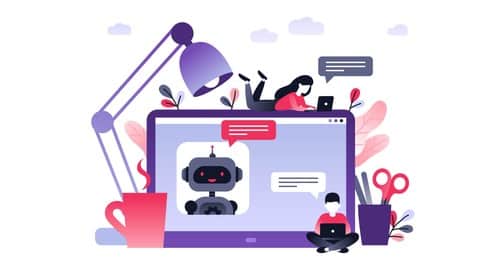- Регистрация
- 27 Авг 2018
- Сообщения
- 40,599
- Реакции
- 654,288
- Тема Автор Вы автор данного материала? |
- #1

- have a demo chatbot that they can tweak and suit to their needs
- have an intelligent chatbot build in a website
- IDE for writing code (Visual Studio code or Webstorm or Sublime or any editor you prefer and are used to)
- you need a basic knowledge of nodejs, react and GIT
In this course, you will build a chatbot for a Webpage. We'll use Node.js and React for programming and GIT for deploying and version control. The bot will be hosted on Heroku, but you can simply host it anywhere else where they support Node.js. We'll use DialogFlow to process natural language. DialogFlow will help us understand what users want.
In the course, we'll be building a sample chatbot. Its purpose is only to show you how things work. Our bot on the page will help us sell products. It will give recommendations and measure demand.
In the process of building this chatbot, you'll learn all that is needed to build a great bot. To get the most out of the course, you can work on this sample bot, and in the end, tweak it to suit your needs.
You need to have at least basic knowledge of Node.js and React to start with this course. For versioning, we use GIT; therefore, you need to be familiar at least with basic git commands.
To make it easier for you, I've added git commits with changes to every video that has a change in the code. This way, you can compare your code to mine. And you won't lose time debugging. And remember for any questions I'm available in the Questions and answers. You are not alone.
And remember, I'LL BE THERE FOR YOU.
The bot will be able to remember things, that is store information into a database or connect to other API services. I'll show you different implementations so that you can play and find out what suits you most.
At the end of the course, you'll have a demo chatbot that you can tweak and tailor to your needs.
My name is Jana Bergant, and I'm a developer with over 20 years of experience. I'm an IT instructor teaching people new tech skills. Over 17000 people are already taking my course.
I help all my students at every step of development. And I'll be here for you!
Let me tell you a bit about every section of this course.
In the first section, we'll take an overview of the app and get familiar with the tech stack, which is the technology used in this course. We'll look at application architecture and different ways we can implement it. We'll go through every implementation. And I'll take you through the development stages.
The second section will introduce you to DialogFlow, a natural language processor, that we'll use to understand what our visitors want from the chatbot. We'll go through building blocks of DialogFlow. You'll learn about agents, intents, entities, parameters, prebuild agents, and more.
Then in the third section, we start building the server-side app for the chatbot. We'll install the Express library and generate an express app. After we are trough with configuration, we deploy it to Heroku. To speed up the development process, we'll set up a local development server called Nodemon.
When you have a basic server-side app created, you'll be able to connect it to DialogFlow. And that is what we'll do in section 4.
And frontend will be the next step. In the fifth section, we set up React, configure local servers, create a proxy for communicating with the backend. And we'll develop components. Components for the page and for the chatbot. Our chatbot will begin to look like a chatbot in the 5th section.
But we'll polish it in the 6th section, where we'll create rich messages for the chatbot like cards and quick replies. And also, we'll go deeper into DialogFlow's features, like follow up intents, contexts, events, and slot feelings. Features that make bot creation much easier and much friendlier!
When our bot is polished, we can make it smarter. We want our bot to remember what the user says. Therefore we need to store information that we get from the user. In the 7th section, we'll be saving to the database and also use what we know about the user in a conversation. To make the bot friendlier. We like if people remember our preferences, it is the same with bots.
In the 8th section, I'll show you a different way to implement handling actions. We'll be using DialogFlow's fulfillment. I'll show you how to call fulfillment only for intents that need extra code to be run. Only for intents that need to get information from a database, or that need to call some other API, or maybe connect to a device.
When we master fulfillment, we'll deploy to Heroku. In the 9th section, we'll take care of some extra configuration like routing, postbuild scripts for generating frontend; we'll also go through the code and make sure all is as needed before we deploy.
And finally, in the 10th section, I'll show you how to connect to DialogFlow straight from FrontEnd. To do that, we'll need to make some changes to the architecture. I'll tell you the benefits of every decision.
After the course, you'll have a demo bot that you can tweak and tailor to your needs. And you'll have the knowledge to upgrade it.
See you on the course!
Jana
The last update of the course was on 27th February 2020
I added DialogFlow mega agents
Who this course is for
- has at least a basic programming skills (nodejs & react)
- everyone who is interested in conversational commerce
- everyone who want's to build a chatbot for the page
DOWNLOAD:



